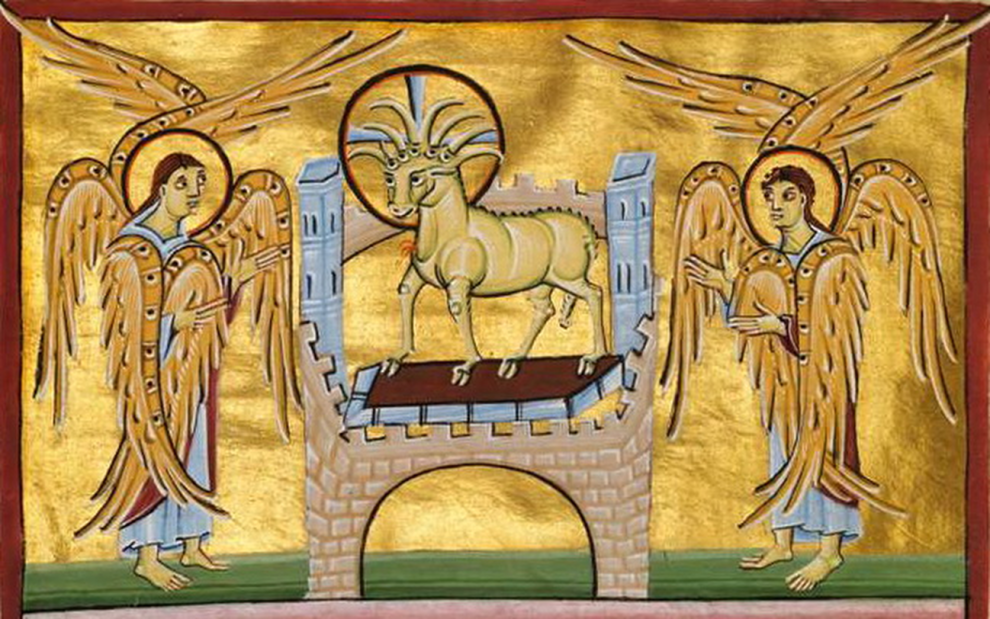While scholars continue to do extensive research and reflection on the Book of Revelation, there are some who approach it with a different intent: to try to validate sociopolitical and economic ideologies. This is the topic of Stephen D. Moore’s Revelation: Book of Torment, Book of Bliss. An Introduction and Study Guide (T&T Clark). Moore provides a succinct, dense, and comprehensive study of how scholars engage with Revelation, as well as how it’s become the subject of ideological proof-texting. “How we read Revelation depends on what we understand Revelation to be,” he writes.
Moore first engages with the history of scholarly interpretations and reflections on Revelation while offering his own interpretative views as well. The reality is that actual scholarship on Revelation is minimal in comparison with the vast number of popular interpretations that claim the prophecies and warnings address an imminent future. Moore himself is drawn to the book, he says, because of its poetry, surreal imagery, and extravagant language.
In terms of historical context, the book is a plea to the churches to distance themselves from Rome because the empire has been marked for destruction. In this sense, Revelation can furnish individuals and groups with ways of thinking about the future. Latin American liberation theologians, for instance, find in the book a potent inspiration for social justice—similar to the way enslaved African in the American south drew on apocalyptic imagery to compose songs of resistance. Revelation can provide context for critiques of empire (whether ancient or modern), for speaking against state-sponsored oppression, and for comforting the oppressed.
In his second chapter, Moore provides an overview of apocalyptic interpretations of Revelation, from the medieval period to today. Often, people have appropriated Revelation and tried to force it to speak to their own contexts, insisting that the book was written to disclose events that, at the time of its writing, were still centuries in the future.
Fiction writers have drawn heavily on Revelation to create an aura of the apocalyptic, assigning roles to China, Russia, or the United States, based on their own readings. For instance, in one novel Moore discusses, the author puts an apocalyptic interpretation on the military activities of the Chinese army and identifies the European Union as the new Roman Empire to be led by the antichrist. Cold war paranoia, as Moore recounts, got an apocalyptic twist with assurances that believers would be saved from nuclear holocaust in “God’s bunker.” And writers have selected various U.S. presidents as possible candidates for the beast of Revelation. Filmmakers, too, have drawn on Revelation for visuals and imagery. For example, the title of the 1972 movie A Thief in the Night alludes to passages from Revelation and other books from Christian scripture. Video games, too, borrow from Revelation’s violent scenes.
Moore then looks at intertextual expositions of Revelation, inviting readers to see the book through the lens of the Hebrew Bible. Revelation contains more allusion to Jewish scripture than any other New Testament text, with images borrowed from Isaiah, Ezekiel, Daniel, and the Psalms and allusions to Exodus’ plagues to describe cosmic disasters. Revelation’s language also imitates patterns from Jewish scripture, with grammar and syntax more characteristically Aramaic than Greek. Moore identifies the author’s literary artistry as an internalization of “an intricate but unwritten set of rules for generating apocalyptic discourse.”
Numbers are important in Revelation, and Moore offers a meticulous exposition of numerical symbolism, especially the number seven, which is biblically significant beyond the book of Revelation. This numerical motif, popular among ancient near-eastern cultures, takes on layers of theological meaning in Judaism, especially in the writings of the diasporic Jewish philosopher, Philo of Alexandria.
Other significant numbers in Revelation include four and 12. The 24 elders of Revelation stand for the 12 patriarchs of Israel plus the 12 apostles of the lamb. The number of believers who belong to God is 144,000 (12 times 12 times 1000). The purpose of these numbers, for the author of Revelation, is to indicate that every event in history is part of the divine plan: Nothing happens by chance.
Moore goes on to share some common interpretations of selected passages from Revelation. He presents a post-colonial interpretation of Revelation 1:14–5, which describes Jesus as having “hair like wool” and “feet like burnished bronze.” These descriptions appeal to people of African descent, and Moore notes that Africans, both on the continent and in diaspora, and the Rastafari religious community in Jamaica, interpret these passages “to counter the long Eurocentric tradition of erasing the presence of dark-skinned people from biblical history and whitening the figure of Jesus in particular.” He also suggests that Jesus of Revelation 1:13–16 appears as female—though described with masculine pronouns. At the same time, drawing on feminist scholars, he notes that people have utilized Revelation to harm women because “anything symbolized as female is an object of violence” in the book. But even though the Christology of Revelation gives voice to Africans, women, and gender non-conforming persons, the most imposing image of Jesus in Revelation is as a non-human animal.
A major point in Revelation, Moore explains, is that God’s empire supersedes the Roman empire in both glory and violence. Like the Roman empire, God’s empire will be established by war and conquest. Even dire things like the magnitude of human corpses, the mass extinction of nonhuman species, and the total obliteration of the Earth are testaments to God’s military campaign. In going after those who destroy the Earth, the agents of God inflict collateral damage with a power unmatched by human destroyers, making the Earth unhabitable. But this destruction is not the end of the story. Accordingly, the Earth will be transformed, human inhabitants will experience renewal, and there will be no more war.
Moore’s book is more of an introductory text than a source of original scholarship. On the topic of the christology of Revelation, Moore touches on some postcolonial perspectives; otherwise, the book is short on details on this theme. It might have benefited from looking at other christological themes in the NT for details and perspective: For instance, what is the significance of the “one like the son of man” in Revelation 1:13, who also appears at the harvest of the Earth in 14:14? More could have been said about the various christological images in the text.
In general, however, this book serves as both an introduction and a study guide that will enthrall any reader of Revelation. Teachers, students, pastors, bible study groups, and anyone who is captivated by this astonishing work of poetry will appreciate Moore’s clarity, accessibility, and detailed analysis.
Image: Wikimedia Commons/The Lamb with the Book of the Seven Seals, from the Bamberger Apocalypse, c. 1600












Add comment